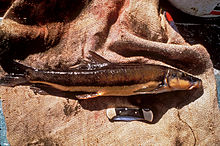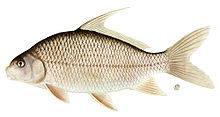Sucker carp
| Sucker carp | ||||||||||||
|---|---|---|---|---|---|---|---|---|---|---|---|---|

|
||||||||||||
| Systematics | ||||||||||||
|
||||||||||||
| Scientific name | ||||||||||||
| Catostomidae | ||||||||||||
| Agassiz , 1855 |
The suction carp (Catostomidae), suckers or suckers are a family of carp-like (Cypriniformes). They occur in North America , northeastern Siberia and in eastern China (only one species there). The main distribution area is North America, where they are among the most common fish.
features
Suckers from fast-flowing waters are slim, and from slow-flowing waters they are tall. The eleven centimeters to a maximum of 1.20 meters long animals, most of them stay under 60 centimeters, are mostly inconspicuous, of brown or gray color. The mouth is usually below and protractile (can be turned forward), in plankton eaters terminal. Your lips are usually fleshy, thick, and papillae or hairy. Barbels are absent. On the pharyngeal jaw is a series of 16 or more pharyngeal teeth . The swim bladder is large with two to three chambers.
Way of life
Suckers mainly eat benthic food with their thick-lipped, inferior mouths . A specially adapted ecotype are the small mountain suckers like Hypentelium , which live in fast-flowing mountain streams and scrape off algae and invertebrates from the stones with their horned lips, analogous to the loaches in the old world . Another is the high-backed plankton eater of the large lakes and large, slow-flowing rivers. They live in open water.
External system
The suction carp belong to the order of the carp-like (Cypriniformes). Relationship analyzes on the exact position of the family using molecular genetic data led to different results, according to which the suckers are on the one hand the sister group of all loach families, but on the other hand the sister group of all carp-like species. The family relationships are illustrated by the following cladogram :
| Carp-like (Cypriniformes) |
|
|||||||||||||||||||||||||||||||||||||||||||||||||||||||||
|
|
Internal system
There are about 80 species , most of them in the genera Catostomus and Moxostoma .
- Subfamily Catostominae ; Northeastern Siberia to Mexico , fin formula : dorsal 10–18, anal 7, 30–120 scales along the sideline .
- Tribe Catostomini
- Genus Catostomus Lesueur, 1817
- Catostomus ardens Jordan & Gilbert, 1881 .
- Catostomus Bernardini Girard, 1856 .
- Catostomus bondi Smith, Stewart & Carpenter, 2013 .
- Catostomus cahita Siebert & Minckley, 1986 .
- Catostomus catostomus (Forster, 1773) .
- Catostomus clarkii Baird & Girard, 1854 .
- Catostomus columbianus (Eigenmann & Eigenmann, 1893) .
- Catostomus commersonii ( Lacépède , 1803) .
- Catostomus discobolus Cope, 1871 .
- Catostomus fumeiventris Miller, 1973 .
- Catostomus insignis Baird & Girard, 1854 .
- Catostomus latipinnis Baird & Girard, 1853 .
- Catostomus leopoldi Siebert & Minckley, 1986 .
- Catostomus macrocheilus Girard, 1856 .
- Catostomus microps Rutter, 1908 .
- Catostomus nebuliferus Garman, 1881 .
- Catostomus occidentalis Ayres, 1854 .
- Catostomus platyrhynchus (Cope, 1874) .
- Catostomus plebeius Baird & Girard, 1854 .
- Catostomus rimiculus Gilbert & Snyder in Gilbert, 1898 .
- Catostomus santaanae (Snyder, 1908) .
- Catostomus snyderi Gilbert, 1898 .
- Catostomus tahoensis Gill & Jordan in Jordan, 1878 .
- Catostomus warnerensis Snyder, 1908 .
- Catostomus wigginsi Herre & Brock in Herre, 1936 .
- Genus Chasmistes Jordan, 1878
- Chasmistes brevirostris Cope , 1879 .
- Chasmistes cujus Cope, 1883 .
- Chasmistes fecundus (Cope & Yarrow, 1875) .
- Chasmistes liorus Jordan, 1878 .
- Genus Deltistes Seale, 1896
- Deltistes luxatus ( Cope , 1879) .
- Genus Xyrauchen Eigenmann & Kirsch in Kirsch, 1889
- Xyrauchen texanus (Abbott, 1860) .
- Genus Catostomus Lesueur, 1817
- Tribe Moxostomatini
- Genus Erimyzon Jordan, 1876
- Erimyzon oblongus ( Mitchill , 1814) .
- Erimyzon sucetta ( Lacépède , 1803) .
- Erimyzon tenuis ( Agassiz , 1855) .
- Genus Hypentelium Rafinesque, 1818
- Hypentelium etowanum ( Jordan , 1877) .
- Hypentelium nigricans ( Lesueur , 1817) .
- Hypentelium roanokense Raney & Lachner, 1947 .
- Genus Minytrema Jordan, 1878
- Minytrema melanops ( Rafinesque , 1820) .
- Genus Moxostoma Rafinesque, 1820
- Moxostoma albidum (Girard, 1856) .
- Moxostoma anisurum (Rafinesque, 1820) .
- Moxostoma ariommum Robins and Raney, 1956 .
- Moxostoma austrinum Bean, 1880 .
- Moxostoma breviceps (Cope, 1870) .
- Moxostoma carinatum (Cope, 1870) .
- Moxostoma cervinum (Cope, 1868) .
- Moxostoma collapsum (Cope, 1870) .
- Moxostoma congestum (Baird & Girard, 1854) .
- Moxostoma duquesnii (Lesueur, 1817) .
- Moxostoma erythrurum (Rafinesque, 1818) .
- Moxostoma hubbsi Legendre, 1952 .
- Moxostoma lacerum (Jordan & Brayton, 1877) .
- Moxostoma lachneri Robins & Raney, 1956 .
- Moxostoma macrolepidotum (Lesueur, 1817) .
- Moxostoma mascotae Regan, 1907 .
- Moxostoma pappillosum (Cope, 1870) .
- Moxostoma pisolabrum Trautman & Martin, 1951 .
- Moxostoma poecilurum Jordan, 1877 .
- Moxostoma robustum (Cope, 1870) .
- Moxostoma rupiscartes Jordan & Jenkins in Jordan, 1889 .
- Moxostoma valenciennesi Jordan, 1885 .
- Genus Thoburnia Jordan & Snyder in Jordan, 1917
- Thoburnia atripinnis (Bailey, 1959) .
- Thoburnia hamiltoni (Raney & Lachner, 1946) .
- Thoburnia rhothoeca (Thoburn, 1896) .
- Genus Erimyzon Jordan, 1876
- Tribe Catostomini
- Subfamily Ictiobinae ; Canada to Guatemala (not in rivers that drain into the Pacific), fin formula : dorsal 22–32, anal 7–11, 33–43 scales along the lateral line , 115–190 pharyngeal teeth.
- Genus Carpiodes Rafinesque, 1820
- Carpiodes carpio (Rafinesque, 1820)
- Carpiodes cyprinus (Lesueur, 1817)
- Carpiodes velifer (Rafinesque, 1820)
- Genus Ictiobus Rafinesque, 1820
- Ictiobus bubalus (Rafinesque, 1818)
- Ictiobus cyprinellus (Valenciennes in Cuvier & Valenciennes, 1844)
- Ictiobus labiosus (Meek, 1904)
- Ictiobus meridionalis (Günther, 1868)
- Ictiobus niger (Rafinesque, 1819)
- Genus Carpiodes Rafinesque, 1820
- Subfamily Cycleptinae; Fin formula : dorsal 28–37, anal 7, 51–59 scales along the lateral line .
- Genus Cycleptus Rafinesque, 1819
- Cycleptus elongatus ( Lesueur , 1817) .
- Cycleptus meridionalis Burr & Mayden, 1999 .
- Genus Cycleptus Rafinesque, 1819
- Subfamily Myxocyprininae; Eastern China (river basin of the Yellow River and the Yangtze ), fin formula : dorsal 52–57, anal 12–14, 47–55 scales along the lateral line , juvenile fish with high backed bodies and very high dorsal fin.
- Genus Myxocyprinus Gill, 1878
- Myxocyprinus asiaticus ( Bleeker , 1865) .
- Genus Myxocyprinus Gill, 1878
Fossils
The family can be found in fossil records since the Eocene . An extinct genus is Amyzon , which occurred in North America from the Eocene to the Oligocene . Extinct species of the recent genus Deltistes have also been described.
literature
- Joseph S. Nelson : Fishes of the World , 438, John Wiley & Sons, 2006, ISBN 0-471-25031-7
- Kurt Fiedler: Textbook of Special Zoology, Volume II, Part 2: Fish . Gustav Fischer Verlag Jena, 1991, ISBN 3-334-00339-6
Individual evidence
- ↑ a b Jörg Bohlen, Vendula Šlechtová: Phylogenetic position of the fish genus Ellopostoma (Teleostei: Cypriniformes) using molecular genetic data. Ichthyological Exploration of Freshwaters. Vol. 20, No. 2, 2009, pp. 157–162 ( PDF ; 1.8 MB)
- ↑ Richard L. Mayden, Kevin L. Tang, Robert M. Wood, Wei-Jen Chen, Mary K. Agnew, Kevin W. Conway, Lei Yang, Andrew M. Simons, Henry L. Bart, Phillip M. Harris, Junbing Li, Xuzhen Wang, Kenji Saitoh, Shunping He, Huanzhang Liu, Yiyu Chen, Mutsumi Nishida, Masaki Miya: Inferring the Tree of Life of the order Cypriniformes, the earth's most diverse clade of freshwater fishes: Implications of varied taxon and character sampling. Journal of Systematics and Evolution. Vol. 46, No. 3, 2008, pp. 424–438 ( PDF , 455 kB)
- ↑ a b Wei-Jen Chen, V. Lheknim, Richard L. Mayden: Molecular phylogeny of the Cobitoidea (Teleostei: Cypriniformes) revisited: position of enigmatic loach Ellopostoma resolved with six nuclear genes. Journal of Fish Biology. Vol. 75, No. 9, 2009 pp. 2197-2208, doi : 10.1111 / j.1095-8649.2009.02398.x
- ^ Karl Albert Frickhinger: Fossil Atlas Fish , Mergus-Verlag, Melle, 1999, ISBN 3-88244-018-X
Web links
- Sucker carp on Fishbase.org (English)












